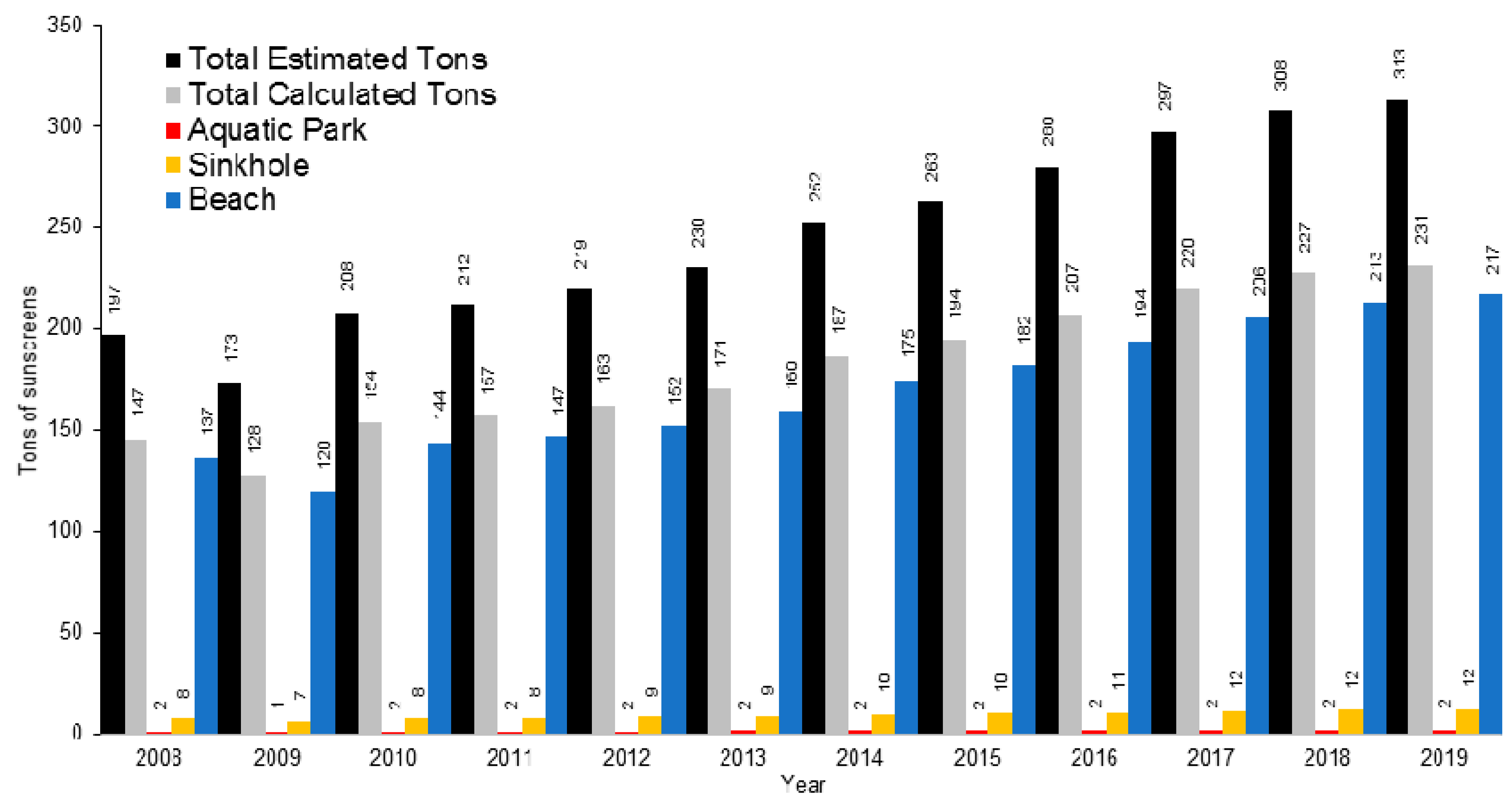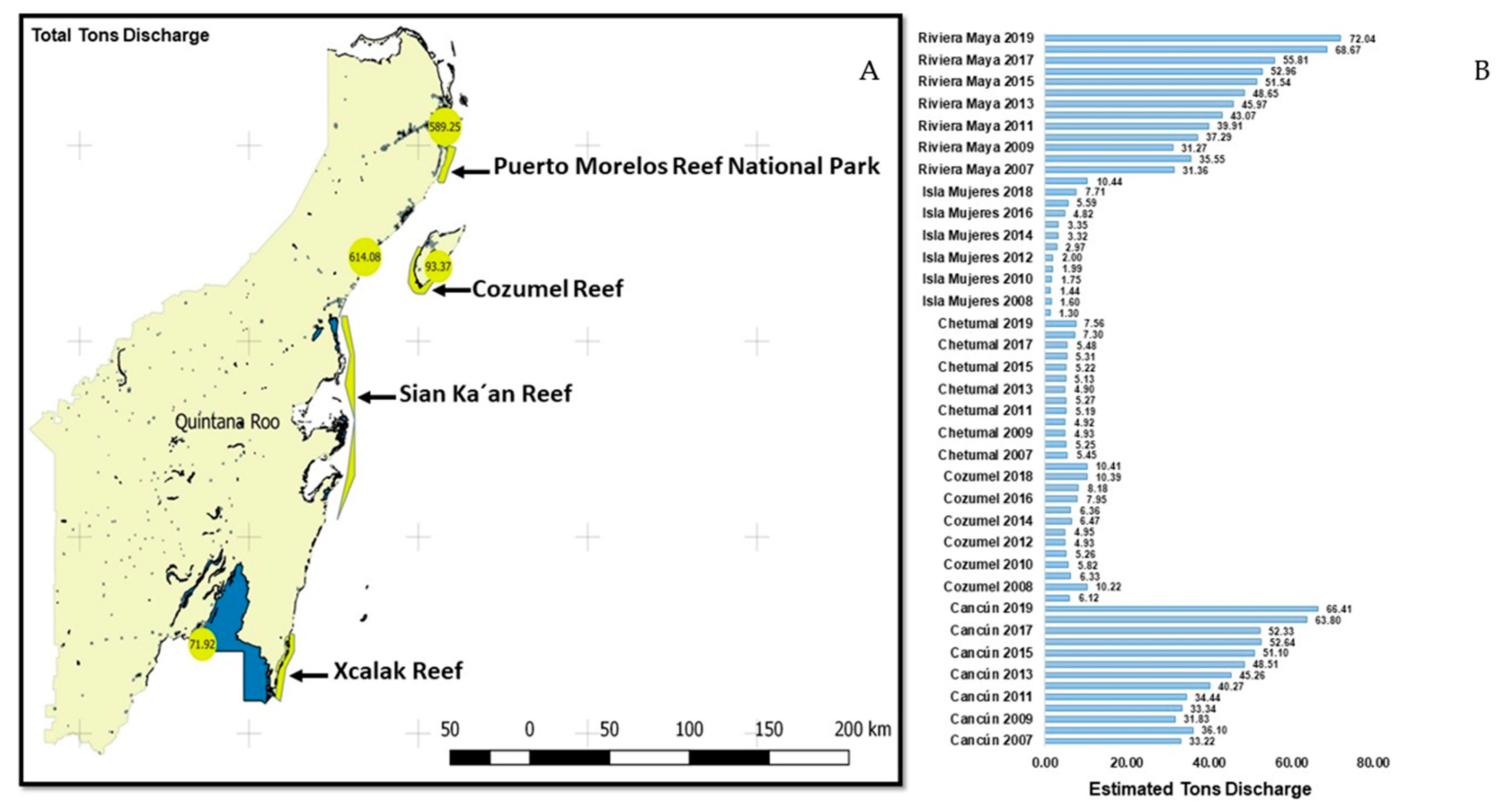Impact of Tourist Behavior on the Discharge of Sunscreen Contamination in Aquatic Parks, Sinkholes, and Beaches of the Mexican Caribbean
Abstract
1. Introduction
2. Materials and Methods
2.1. Study Area
2.2. Surveys
2.3. Environmental Legislation
2.4. Discharge Estimation of Sunscreens
3. Results
4. Discussion
5. Conclusions
Author Contributions
Funding
Institutional Review Board Statement
Informed Consent Statement
Acknowledgments
Conflicts of Interest
References
- SECTUR. Resultados de la Actividad Turística. 2018. Available online: https://www.datatur.sectur.gob.mx/RAT/RAT-2018-12(ES).pdf (accessed on 10 December 2019).
- Córdoba y Ordóñez, J.; García De Fuentes, A. Turismo, globalización y medio ambiente en el Caribe mexicano. Investig. Geográficas. 2003, 52, 117–136. [Google Scholar]
- Casas-Beltrán, D.A.; Gallaher, C.M.; Yac, E.H.; Moreno, K.F.; Voglesonger, K.; Leal-Bautista, R.M.; Lenczewski, M. Seaweed invasion! Temporal changes in beach conditions lead to increasing cenote usage and contamination in the Riviera Maya. Sustainability 2020, 12, 2474. [Google Scholar] [CrossRef]
- Leal-Bautista, R.M.; Lenczewski, M.; Morgan, C.; Gahala, A.; McLain, J.E. Assessing fecal contamination in groundwater from the Tulum Region, Quintana Roo, Mexico. J. Environ. Prot. 2013, 1272–1279. [Google Scholar] [CrossRef][Green Version]
- Sanchez-Quiles, D.; Blasco, J.; Tovar-Sánchez, A. Sunscreen components are a new environmental concern in coastal waters: An overview. In Sunscreens in Coastal Ecosystems, The Handbook of Environmental Chemistry; Tovar-Sánchez, A., Sánchez-Quiles, D., Blasco, J., Eds.; Springer: Cham, Switzerland, 2020; Volume 94. [Google Scholar] [CrossRef]
- Sánchez-Quiles, D.; Tovar-Sánchez, A. Are sunscreens a new environmental risk associated with coastal tourism? Environ. Int. 2015, 83, 158–170. [Google Scholar] [CrossRef] [PubMed]
- Downs, C.A.; Kramarsky-Winter, E.; Segal, R.; Fauth, J.; Knutson, S.; Bronstein, O.; Ciner, F.R.; Jeger, R.; Lichtenfeld, Y.; Woodley, C.M.; et al. Toxicopathological effects of the sunscreen UV filter, Oxybenzone (Benzophenone-3), on coral planulae and cultured primary cells and its environmental contamination in Hawaii and the US Virgin Islands. Arch. Environ. Contam. Toxicol. 2015, 70, 265–288. [Google Scholar] [CrossRef] [PubMed]
- Healthy Reefs. Report Card for the Mesoamerican Reef: An Evaluation of Ecosystem Health. Healthy Reefs Initiative. 2012. Available online: https://www.healthyreefs.org/cms/report-cards/ (accessed on 20 January 2020).
- Giokas, D.L.; Salvador, A.; Chisvert, A. UV filters: From sunscreens to human body and the environment. TrAC Trends Anal. Chem. 2007, 26, 360–374. [Google Scholar] [CrossRef]
- Brausch, J.M.; Rand, G.M. A review of personal care products in the aquatic environment: Environmental concentrations and toxicity. Chemosphere 2011, 82, 1518–1532. [Google Scholar] [CrossRef]
- Hernández Pedraza, M.; Caballero-Vazquez, J.; Peniche-Pérez, J.C.; Pérez-Legaspi, I.G.; Casas-Beltran, D.A.; Alvarado-Flores, J. Toxicity and hazards of biodegradable and non-biodegradable sunscreens to aquatic life of Quintana Roo, Mexico. Sustainability 2020, 12, 3270. [Google Scholar] [CrossRef]
- Casas-Beltran, D.A.; Hernández-Pedraza, M.; Alvarado-Flores, J. Estimation of the discharge of sunscreens in aquatic environments of the Mexican Caribbean. Enviroments 2020, 7, 15. [Google Scholar] [CrossRef]
- Rodríguez-Fuentes, G.; Luna-Ramírez, K.; Soto, M. Sunscreen Use behavior and most frequently used active ingredients among beachgoers on Cancun, Mexico. WebmedCentral Dermatol. 2010, 1, WMC001364. Available online: http://www.webmedcentral.com/article_view/1364 (accessed on 20 January 2020).
- Ley de Protección al Medio Ambiente del Estado de Yucatán. Available online: http://legismex.mty.itesm.mx/estados/ley-yuc/YUC-L-ProtMedAmb2018_03.pdf (accessed on 20 January 2020).
- Reglamento de Cenotes, Cuevas y Pozos Comunitarios del Municipio de Mérida. Gaceta Municipal 100 2012. Available online: https://isla.merida.gob.mx/serviciosinternet/normatividad/files/Reglamentos/CENOTES_POZOS.pdf (accessed on 20 January 2020).
- Reglamento de la Ley de Protección al Medio Ambiente del Estado de Yucatán en Materia de Cenotes, Cuevas y Grutas. Available online: https://www.poderjudicialyucatan.gob.mx/digestum/marcoLegal/05/2014/DIGESTUM05065.pdf (accessed on 20 January 2020).
- Decreto Número 117—Se Establece el Área Natural Protegida Denominada Reserva Estatal Geohidrológica del Anillo de Cenotes. Diario Oficial del Gobierno del Estado de Yucatán. Available online: http://www.yucatan.gob.mx/docs/diario_oficial/diarios/2013/2013-10-28_2.pdf (accessed on 20 January 2020).
- Ley del Equilibrio Ecologico y la Proteccion al Ambiente del Estado de Quintana Roo. Available online: http://documentos.congresoqroo.gob.mx/leyes/L22-XV-16082018-741.pdf (accessed on 20 January 2020).
- Ley de Asentamientos Humanos, Ordenamiento Territorial y Desarrollo Urbano del Estado de Quintana Roo. Congreso del Estado de Quintana Roo. Available online: http://documentos.congresoqroo.gob.mx/leyes/L191-XV-16082018-741.pdf (accessed on 20 January 2020).
- Reglamento de Actividades en Cenotes, Cavernas y Grutas del Municipio de Solidaridad, Quintana Roo. Periódico Oficial del Estado de Quintana Roo. Available online: http://gobiernodesolidaridad.gob.mx/category/Transparencia/FraccionI/REGLAMENTOS/70UVTAIP.pdf (accessed on 20 January 2020).
- Reglamento de Cenotes y Cavernas del Municipio de Tulum, Q. Roo. Available online: http://www.bucema.com/assets/reglamento-de-cenotes-y-cavernas.pdf (accessed on 20 January 2020).
- Reglamento de Ecología y Gestión Ambiental del Municipio de Benito Juárez, Quintana Roo. Available online: http://cancun.gob.mx/transparencia/files/2018/08/10-ReglamentoDeEcologiaYDeGestionAmbientalDelMunicipioDeBenitoJuarez.pdf (accessed on 20 February 2020).
- Ley General del Equilibrio Ecológico y la Protección al Ambiente. 1994. Available online: https://biblioteca.semarnat.gob.mx/janium/Documentos/Ciga/agenda/DOFsr/148.pdf (accessed on 20 January 2020).
- Poiger, T.; Hans-Rudolf, B.; Balmer, E.M.; Per-Anders, B.; Müller, D.M. Occurrence of UV filter compounds from sunscreen in surface water: Regional mass balance in two Swiss lakess. Chemosphore 2004, 951–963. [Google Scholar] [CrossRef] [PubMed]
- Slijkerman, D.; Keur, M. Sunscreen Ecoproducts Product Claims, Potential Effects and Environmental Risks of Applied UV Filters. Wagenigen, Netherlands. 2016. Available online: https://library.wur.nl/WebQuery/wurpubs/fulltext/457209 (accessed on 20 January 2020).
- Alcalde, M.T. Cosmética natural y ecológica. OFFARM 2008, 27, 96–104. [Google Scholar] [CrossRef]
- Hughes, T.P.; Anderson, K.D.; Connolly, S.R.; Heron, S.F.; Kerry, J.T.; Lough, J.M.; Claar, D.C. Spatial and temporal patterns of mass bleaching of corals in the Anthropocene. Science 2018, 359, 80–83. [Google Scholar] [CrossRef] [PubMed]


| Category | Name | Decree Date | Year Publication of the Management | With Management Program | With Regulation of Sunscreens | Allows NONBIO | Allows BIO |
|---|---|---|---|---|---|---|---|
| FFPA | Yum Balam | 1994 | 2018 | YES | YES | NO | YES |
| FFPA | Isla Cozumel | 2012 | 2016 | YES | YES | NO | YES |
| NP | Arrecife de Puerto Morelos | 1998 | 2000 | YES | NOT | ||
| NP | Arrecifes de Cozumel | 1996 | 1998 | YES | YES | NO | YES |
| NP | Arrecifes de Xcalak | 2000 | 2004 | YES | YES | NO | YES |
| NP | Costa Occ. de I Mujeres, Pta Cancun y Pta Nizuc | 1996 | 2016 | YES | YES | NO | YES |
| NP | Isla Contoy | 1998 | 2015 | YES | YES | NO | YES |
| NP | Tulum | 1981 | - | NO | |||
| BR | Arrecifes de Sian Ka’an | 1986 | 2014 | YES | YES | NO | YES |
| BR | Banco Chinchorro | 1996 | 2000 | YES | YES | NO | YES |
| BR | Sian Ka’an | 1986 | 2014 | YES | YES | NO | YES |
| S | Playa de la Isla Contoy | 1986 | - | NO | |||
| BR | Tiburón Ballena | 2009 | 2015 | YES | YES | NO | YES |
| FFPA | Bala’an Ka’ax | 2005 | 2007 | YES | NO | ||
| FFPA | Uaymil | 1994 | 2014 | YES | YES | NO | YES |
| FFPA | Manglares de Nichupte | 2008 | 2014 | YES | NO | ||
| BR | Reserva de la Biósfera Caribe Mexicano | 2016 | 2018 | YES | NO |
| Laws and Regulations | Regulates Tourisms | Encourages the Conservation of Aquatic Systems | Allows Sunscreens | Type NONBIO | Type BIO |
|---|---|---|---|---|---|
| Ley de protección al medio ambiente del Estado de Yucatán, 2010 [14] | Yes | Yes | Yes | No | Yes |
| Reglamento de cenotes, cuevas y pozos comunitarios del municipio de Mérida, 2012 [15] | Yes | Yes | Yes | No | No |
| Reglamento de la Ley de Protección al Medio Ambiente del Estado de Yucatán en Materia de Cenotes, Cuevas y Grutas, 2014 [16] | Yes | Yes | Yes | No | Yes |
| Decreto número 117—Se establece el área natural protegida denominada reserva estatal geohidrológica del Anillo de Cenotes, 2013 [17] | No | Yes | No | ||
| Ley del equilibrio ecológico y la protección al ambiente del estado de Quintana Roo, 2001 [18] | No | Yes | No | ||
| Ley de Asentamientos Humanos, Ordenamiento Territorial y Desarrollo Urbano del Estado de Quintana Roo, 2018 [19] | No | Yes | No | ||
| Reglamento de actividades en cenotes, cavernas y grutas del municipio de Solidaridad, Quintana Roo, 2017 [20] | Yes | Yes | Yes | No | Yes |
| Reglamento de actividades en cenotes, cavernas y grutas del municipio de Tulum, Quintana Roo, 2015 [21] | Yes | Yes | Yes | No | No |
| Reglamento de Ecología y Gestión Ambiental del Municipio de Benito Juárez, Quintana Roo, 2015 [22] | Yes | Yes | No | ||
| Ley General del Equilibrio Ecológico y la Protección al Ambiente, 1994 [23] | Yes | Yes | No |
Publisher’s Note: MDPI stays neutral with regard to jurisdictional claims in published maps and institutional affiliations. |
© 2021 by the authors. Licensee MDPI, Basel, Switzerland. This article is an open access article distributed under the terms and conditions of the Creative Commons Attribution (CC BY) license (https://creativecommons.org/licenses/by/4.0/).
Share and Cite
Casas-Beltrán, D.A.; Febles-Moreno, K.; Hernandez-Yac, E.; Gallaher, C.M.; Alvarado-Flores, J.; Leal-Bautista, R.M.; Lenczewski, M. Impact of Tourist Behavior on the Discharge of Sunscreen Contamination in Aquatic Parks, Sinkholes, and Beaches of the Mexican Caribbean. Appl. Sci. 2021, 11, 6882. https://doi.org/10.3390/app11156882
Casas-Beltrán DA, Febles-Moreno K, Hernandez-Yac E, Gallaher CM, Alvarado-Flores J, Leal-Bautista RM, Lenczewski M. Impact of Tourist Behavior on the Discharge of Sunscreen Contamination in Aquatic Parks, Sinkholes, and Beaches of the Mexican Caribbean. Applied Sciences. 2021; 11(15):6882. https://doi.org/10.3390/app11156882
Chicago/Turabian StyleCasas-Beltrán, Diego Armando, Karelys Febles-Moreno, Emely Hernandez-Yac, Courtney Maloof Gallaher, Jesús Alvarado-Flores, Rosa María Leal-Bautista, and Melissa Lenczewski. 2021. "Impact of Tourist Behavior on the Discharge of Sunscreen Contamination in Aquatic Parks, Sinkholes, and Beaches of the Mexican Caribbean" Applied Sciences 11, no. 15: 6882. https://doi.org/10.3390/app11156882
APA StyleCasas-Beltrán, D. A., Febles-Moreno, K., Hernandez-Yac, E., Gallaher, C. M., Alvarado-Flores, J., Leal-Bautista, R. M., & Lenczewski, M. (2021). Impact of Tourist Behavior on the Discharge of Sunscreen Contamination in Aquatic Parks, Sinkholes, and Beaches of the Mexican Caribbean. Applied Sciences, 11(15), 6882. https://doi.org/10.3390/app11156882





